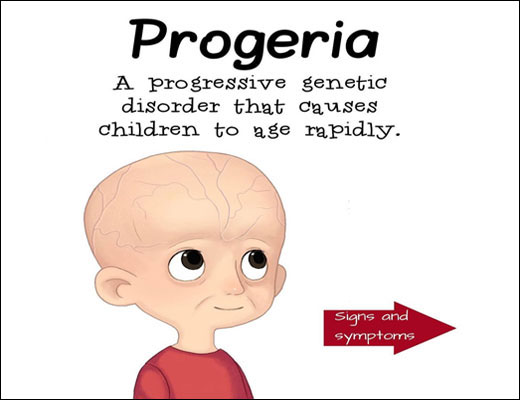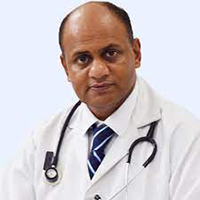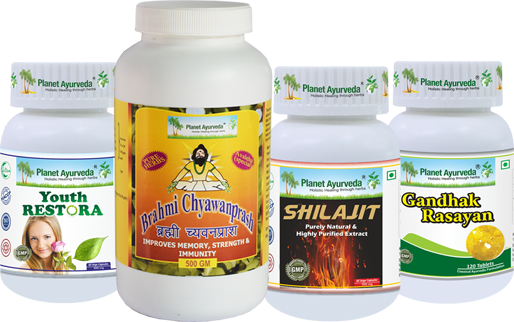Ayurvedic Treatment For Progeria with Herbal Remedies
Abstract
Life is so unpredictable! You must agree with this line. I am saying this because one incident can change someone’s whole life. That’s why we say Health is wealth! In today’s article I am going to discuss the rarest disorder caused due to mutation of gene, in which the children start to age rapidly. At birth the child appears normal but the symptoms start to appear within 2 years of life. This disorder is called Progeria or Hutchinson-Gilford syndrome. Let’s start discussing it in detail.

Introduction
Progeria is also known as Hutchinson-Gilford syndrome. It is a genetic condition in which premature ageing starts at a very early age. Children with progeria have a characteristic facial appearance with a large head, narrow nose, small chin and mouth and large eyes. Patients may suffer from dental and joint abnormalities, baldness, Hip dislocation, loss of fat under the skin and many more. Progeria is mainly caused due to genetic mutation in the LMNA gene and most of the patients may die in their teens. Being a genetic disorder it may not inherit from the parent but there is a mutation in the formed gene.
What Is Progeria And Its Symptoms?
Progeria is a condition of premature ageing that starts within 1 or 2 year of life. A progeria child is normal at birth but after that the process of ageing starts and the symptoms appear.
Now we will see how to identify a patient of progeria. Signs and symptoms include:-
- Poor growth
- Thin, weak bones (osteoporosis)
- Baldness (alopecia)
- Stiff joint
- Delayed eruption of teeth
- Progressive heart disease
- Normal intelligence
- Large head size relative to face
- Loss of fat under the skin
- Slow and abnormal tooth development
- A high-pitched voice
- Limited range of motion and possible hip dislocation
- Generalized atherosclerosis, leading to cardiovascular and heart disease
The severity of symptoms may vary from person to person as some people have more symptoms than others.
Diagnosis And Treatment
Diagnosis can be done as per the symptoms or doctors may prefer genetic testing to confirm the disease. As per allopathy there is no treatment for progeria but symptomatic management can be done including dietary modifications, management of cardiac ailments, physical therapy etc. AN FDA approved medicine Lonafarnib aids in managing the progeria symptoms well. It is a farnesyltransferase inhibitor indicated in children with 12 months of age.
Some Interesting Facts About Progeria
Now I’ll tell you some interesting facts about progeria! Let’s have a look at these amazing facts:-
- A 12-year-old South African girl named Ontlametse Phalatse is the first black child to be born with this fatal condition.
- Mostly the children with progeria die at the age of 13 exclusively from heart disease, commonly suffering from strokes, high blood pressure, angina, enlarged heart and heart failure.
- It is an extremely rare condition occurring one in every four million children.
- Progeria may lead to many serious complications in early teens like heart failure, stroke, joint related complications.
- As per allopathic science it is an incurable condition; only symptomatic management can be done.
- Only 134 children are suffering from Progeria all over the world.
An Ayurvedic Approach Towards Progeria
Ayurveda is an holistic ancient science which holds a solution to every problem.In this ancient literature, every principle about healthy lifestyle is explained like dincharya (Daily regimen), ritucharya (Seasonal regimen), sadvritta (Morals of life) and many more. As per ayurveda, all the diseases are caused due to imbalance of vata, pitta and kapha dosha in the body. So progeria is also due to an imbalance of tridosha in the body. The classical feature of progeria is premature ageing which usually starts within 2 years of life. With the help of ayurveda we can manage this condition in three ways:-
- Use of vyavasthapak drugs (Age stabilizer drugs)
- Rejuvenate the body with jeevaniya gana dravyas
- Rasayan therapy (Rejuvenating processes and formulations)
Acharyas has explained a group of 10 herbs in Charak samhita for the anti-aging process known as vyavasthapan Mahakshaya (Group of anti-ageing herbs). We have another group of herbs which are known as jeevaniya gana (rejuvenating herbs) like Jeevaka, Rishbhaka, Meda, Mahameda, Kakoli, kKheer kakoli etc. They also help in preventing the aging process and keep the patient symptom free. Ayurveda has wonderful herbs and formulations which delays the process of aging and acts as an antioxidant like giloy, Ashwagandha, Dalchini etc.Use of vyavasthapak drugs (age stabilizer drugs).
The herbs included in this are as follows:-
- Amrita (Tinospora cordifolia) – Rasa-Tikta, Kashaya Guna-Guru, Snigdha, Veerya-Ushna, vipaka-Madhura, Dosha action-Tridosha shamaka
- Abhaya (Terminalia chebula) – Rasa-(Pancharas) Kashaya, Guna-Laghu, Ruksh, Veerya-Ushana, vipaka-Madhura, Dosha action-Tridosha Shamak (Vatashamaka)
- Dhatri (Emblica officinalis) – Rasa-(Pancharas) Amla, Guna-Guru, Ruksh, veerya-Shita, Vipaka-Madhura, Dosha action- Tridosha Shamaka Sp.(Pittashamak)
- Yukta (Rasana) (Pluchea lanceolata) – Rasa- Tikta, Guru, Guna-Ushana, Veerya-Katu Dosha action-Vatashamaka
- Shweta (Clitoria ternatea) – Rasa-Katu, Tikta, Guna-Laghu Ruksh, veerya-Shita, vipaka-Katu, Dosha action-Tridosha Shamak
- Jiwanti (Leptadenia reticulata) – Rasa-Madhur, Guna-Laghu, Snigdha, veerya-Shita, vipaka-Madhura, Dosha action-Vata-Pitta shamaka
- Atirasa (Asparagus racemosus) – Rasa-Madhura, Tikta, Guna-Guru, Snigdha, Veerya-Shita, vipaka-Madhura, Dosha action-Vata-Pitta shamaka
- Mandookparni (Centella asiatica) – Rasa-Tikta, Kashaya, Guna-Laghu, Veerya-Shita, Vipaka-Madhura, Dosha action-Kapha-Pitta shamaka
- Sthira (Desmodium gangeticum) – Rasa-Madhura, Tikta, Guna-Laghu, Veerya- Ushna Vipaka-Madhura, Dosha action-Tridosha Shamak
- Punarnava (Boerhavia diffusa) – Rasa-Madhura, Tikta, Guna-Laghu, Ruksh, Veerya- Ushna, Vipaka- Madhura, Dosha action-Tridosha Shamak
Let’s see how these herbs act in patients suffering from progeria!
- Amrita (Tinospora cordifolia) – Also known as giloy, guduchi. It has Guru and snigdha guna which are nutritious in action and are similar to rasa dhatu. Giloy’s Ushna veerya promotes low digestive fire and detoxifies the body by digesting ama (endotoxins). The herb indicates a more anabolic reaction due to its madhura vipaka, thus preventing the process of aging and acts as a rejuvenating agent. That’s why it is recommended for long-term intake in combination with other herbs or formulations. As per modern researches It has been found that the root extract of giloy is immunomodulatory in action.
- Abhaya (Terminalia chebula) – Abhya has vata pacifying properties due to the counteracting action of ushna veerya and mandhur vipaka. It also clarifies all the obstructed channels and does sroto shodhan, thus known as Digestive rasayan (eliminates all the unwanted things from the body). It is well known for its rejuvenating and anti-aging properties due to its panchrasa properties. Haritaki is antioxidant, antidiabetic and purgative in nature.
- Dhatri (Emblica officinals) – Commonly known as amla, amalaki. It has Sheeta Veerya and madhur vipaka thus acts as tridosha shamak but mainly pacifies pitta dosha. Due to its madhur vipaka (process after digestion), it has been noticed that there is more expressed anabolic action of amla as it helps in strengthening the tissues and delays the process of ageing by nourishing the body. Amla is an amazing herb with anti-inflammatory and antioxidant properties.
- Yukta (Pluchea lanceolata) – Rasna is an amazing vata pacifying herb as it has e Guru guna and the heating veerya (potency). It is explained that Vata is the leading cause of jara (Ageing) and is dissociative in nature. Acharya Charak has also said ‘Rasnavataharanama’ in Agrayaprakarana adhyaya of charaka sutrasthana. So it is the best drug for vata. Pluchea lanceolata also possesses Immunomodulatory action.
- Shweta (Clitoria ternatea) – Shweta is a tridosha shamak in nature due to its rasa panchak. As per modern researchers, shweta also possess antibacterial action.
- Jivanti (Leptadenia reticulata) – Jivanti has snigdha guna, madhura rasa, shita virya and madhura vipaka that means it helps in building and strengthening the tissues by supporting kapha dosha. This will promoto ras dhatu and oja and further dhatus to be formed well. Leptadenia reticulata also possess antifungal and antiseptic properties.
- Atirasa (Asparagus racemosus) – Another name of atirasa is shatavari. It is a nourishing or immune-modulating herb which strengthens the body by forming proper dhatus and then saar of all the seven dhatus i.e. oja. It also has antioxidant, anti aging and cell detoxifying properties. Shatavari rejuvenates the skin and body cells thus acts as vaya sthapaka.
- Mandookparni (Centella asiatica) – Mandukaparni also known as gotukola. It promotes good circulation to the peripheres and acts as medhya rasayan (nervine tonic). It is an amazing vaya sthapaka as it directly acts in calming the mind and body. Mandookparmi also promotes good circulation in the blood vessels and body. Therefore it is a very good antioxidant and anti aging agent.
- Sthira (Desmodium gangeticum) – Sthira: This herb suggests that it is a building strengthening herb. It alleviates the kapha dosha and provides nourishment to the body. Its heating virya (hot potency) guards against the excess formation of kledaka kapha. The herb is a cardiotonic which is effective in treating heart conditions. Due to these properties this herb acts as a balyasthapan (anti-aging) herb.
- Punarnava (Boerhavia diffusa) – Punarnava possesses laghu (Light), ruksha (dry) qualities with ushna virya (hot potency) counters the qualities of ama (endotoxins) which is helpful in digesting ama dosha. It is an effective rejuvenative. This herb is derived from two words that is Puna means again and Nava means new, thus this means this herb provides new life to the body cells. These properties make this herb anti-aging. It also promotes the functions of the kidney and liver.
Herbal Remedies For Progeria By Planet Ayurveda
Planet Ayurveda is a trusted and famed organisation offering herbal products worldwide. These products are prepared using ancient time tested formulas. All these formulations are 100% safe and free from adverse effects. Planet ayurveda provides numerous formulations for managing symptoms of progeria, some of them are listed below:-
- Youth Restora
- Shilajit
- Gandhak Rasayan
- Brahmi Chyawanprash
Products Description
1. Youth Restora
Youth restora capsules are polyherbal formulations prepared using Bhumi amla (Phyllanthus niruri), Grape seed (Vitis vinifera), Cow colostrum (Bovine colostrums) etc. All these herbs aid in managing the symptoms of progeria like skin ageing, stiffness in joints, and other disorders of skin, Poor growth, Thin, weak bones (osteoporosis), Baldness (alopecia) etc.
Dosage: 1 twice daily with plain water after meals.
2. Shilajit Capsules
Shilajit capsules is a single herbal safe formulation in capsule form. It is prepared using shuddha shilajit (Asphaltum punjabianum). Shilajit possesses antioxidant, rejuvenating, immune booster and alleviates all the free radicals from the body. Thus helpful in delaying the process of aging in progeria.
Dosage: 1 capsule once a day with plain water after meals.
3. Gandhak Rasayan
Gandhak rasayan is a classical herbal formulation prepared using purified sulphur (gandhak). It is indicated as rasayan (rejuvenating), balya (nourishing) and is wonderful for skin ailments. Being an antioxidant it detoxifies the body and removes all the free radicals. Therefore, it is very useful in managing symptoms of progeria.
Dosage: 1 tablet twice a day with plain water after meals
4. Brahmi Chyawanprash
Brahmi chyawanprash is a classical herbal formulation prepared using herbs like Brahmi (Bacopa monnieri), Dashmoola (root of 10 herbs), Bala (Sida cordifolia), Ashwagandha (Withania somnifera), nagarmotha (Cyperus rotundus), Shatavari (Asparagus racemosus), Bhumi amla (Phyllanthus niruri), Jeevanti (Leptadenia reticulata) and many other herbs. It has antioxidants, antipyretic, Immune boosting, anti aging and blood purifying properties.
Dosage: 1 tsp twice daily with milk.
Conclusion
At last we can conclude that progeria is a progressive deteriorating genetic condition which is rare. But ayurveda being an ancient medicine science has a solution for it. We can improve the quality of life of the patient without causing any adverse effects with classical herbs and herbal formulations. So what are you waiting for? Use these formulations and stay safe and healthy.




